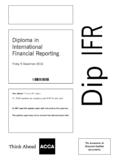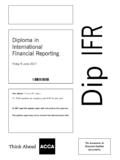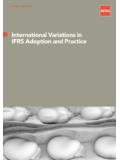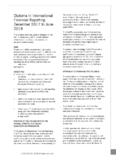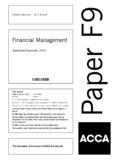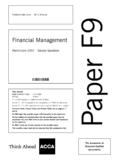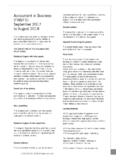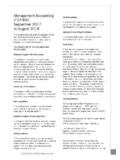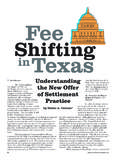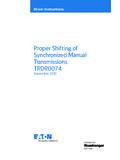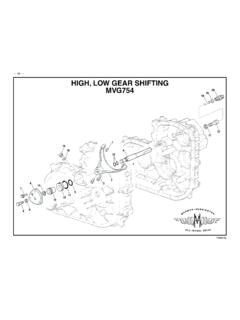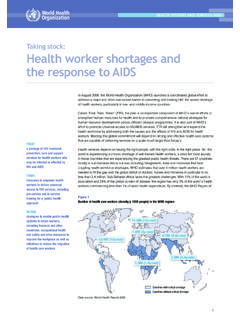Transcription of Share value shifting provisions: income tax and duty ...
1 RELEVANT TO ACCA QUALIFICATION PAPER P6 (MLA) 2012 ACCA Share value shifting provisions : income tax and duty implications This article provides an overview of the Share value shifting provisions , which commonly feature in Question 1 of the Paper P6 (MLA) exam. The relevant articles are articles 5 (13)(b)(ii) of the income Tax Act (ITA) and article 42B of the Duty on Documents and Transfers Act (DDTA) which bring to charge to tax and duty a deemed transfer of value . The Capital Gains Rules and the Duty on Documents and Transfers Rules provide the mechanism for determining the chargeable value .
2 A simple example would be where a company issues new shares at a price below market value to third parties or to some of the existing shareholders and as a result shareholders end up holding shares having a lower value post issue. Another example would be where a shareholder arranges for his/her ordinary shares to be converted into preference shares (entitled to a fixed rate of return) thereby enhancing the value of the remaining ordinary shares . These provisions apply where the market value of shares held by a person (the transferor) in a company has been reduced as a result of a change in the issued Share capital of such company, or a change in any rights attached to such shares , and such value passes into other shares in or rights over the company held by another person (the transferee).
3 In such a case, the transferor is deemed to have made a transfer of value to the transferee, which is calculated by taking into account the difference between the market/real value of the shares held immediately before and after the change. Events, which may trigger a deemed transfer of value , include an allotment of shares , reduction in Share capital, alteration of voting rights and a conversion of securities. The whole scope of the value shifting propositions (VSP) is to bring to charge to tax and duty a transfer of value in the same way and under the same conditions that would have applied if a transfer of shares had taken place.
4 The ITA and DDTA exclude the following situations from the scope of these provisions : Excluded under ITA and DDTA: The change in the issued Share capital, or change in voting rights, does not produce any change in the individual, direct or indirect, beneficial owners of the said company or in the proportion of the value of the said company represented by the shares owned beneficially, directly, or indirectly, by each such individual. 2 Share value shifting provisions : income TAX AND DUTY IMPLICATIONS APRIL 2012 2012 ACCA The company is a company whose securities are listed on a stock exchange recognised under the Financial Markets Act.
5 The company is not a property company and it can be shown to the satisfaction of the Commissioner that the said change is effected for bonafide commercial reasons and does not form part of a scheme or arrangements of which the main purpose, or one of the main purposes, is the avoidance of liability to duty. Excluded under ITA: The change in the issued Share capital consists of an allotment of shares in a company as a result of an exchange of shares on a restructuring of holdings exempt from tax under the provisions of article 5(14).
6 The transfer of value is made by the transferor to his spouse, descendants and ascendants in the direct line and their relative spouses, or in the absence of descendants to his brothers or sisters and their descendants. Excluded under DDTA: The change in the issued Share capital consists of an allotment of shares in a company, as a result of an exchange of shares from one company to another exempt from duty under the provisions of article 42(1). The transfer of value is the result of a change in voting rights and such transfer is made by the transferor to his spouse, descendants and ascendants in the direct line and their relative spouses, or in the absence of descendants to his brothers or sisters and their descendants.
7 Determining the market/real value of shares held immediately before and after the change and value transferred/acquired The value shifting provisions do not apply to shares which do not participate in any way in the profits of a company other than by way of a fixed rate of return. The market value /real value of the company both before and after the change is to be determined in accordance with rules 5 and 6 of the capital gains rules. However, for duty purposes an adjustment may be required in respect of non-deductible liabilities.
8 For the purpose of determining the market/real value of the company the total net asset value taken into account is that resulting from an accounting statement drawn up as at the date of the deemed transfer of value consisting of two balance sheets showing the position of the company immediately before and after the change. The market/real value of shares held in a company is a percentage of the market/real value of the company corresponding to the percentage of the issued Share capital represented by the nominal value of those shares .
9 3 Share value shifting provisions : income TAX AND DUTY IMPLICATIONS APRIL 2012 2012 ACCA However, if the issued Share capital of the company is made up of different classes of shares (whether before or after the change in the issued Share capital) or the change consists of an alteration of voting rights, the market/real value of shares is taken to be the higher of: the percentage of the market/real value of the company corresponding to the percentage of the total voting rights in the company represented by the total voting rights attached to those shares , and the percentage of the market/real value of the company corresponding to the percentage of the issued Share capital represented by the nominal value of those shares .
10 The formula for determining the real/market value transferred/acquired ( Y ) is as follows: Y = (A B) + C D Where: 'A' is the market value of the shares held in the company immediately before the change and 'B' is the market value of the shares held in the company immediately after the change. 'C' is the consideration paid for the acquisition of shares or additional shares issued by the company, where the change consists of an issue of Share capital for consideration and 'D' is the amount paid by the company in respect of a cancellation of shares , where the change consists of a reduction of Share capital of the company.

